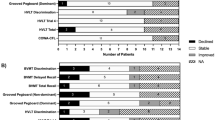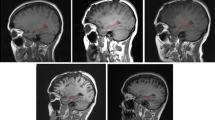Abstract
Following tumor resection, the majority of high-grade glioma (HGG) patients are treated with a combined modality regimen of radiotherapy and temozolomide. As a result of the tumor itself or as treatment-related neurotoxic side-effects, these patients may experience cognitive deficits. Additionally, radiological abnormalities expressed as white matter hyperintensities (WMH) and cerebral atrophy (CA) can develop. In this study, these functional and morphological parameters are evaluated, and their relation is investigated. After surgery, HGG patients underwent chemo-irradiation for six weeks, followed by six cycles of temozolomide. Assessments were performed before chemo-irradiation, post-concomitantly, after the third and sixth adjuvant cycle, and 3 and 7 months after treatment. Degree of WMH and CA was scored on MRI. Patients’ neuropsychological performance was compared to healthy matched controls, yielding six cognitive domain z-scores. Development or progression of pre-existing WMH and CA during follow-up was observed in 36 and 45 % of the patients (n = 39) respectively. Cognitive functioning remained stable or improved in 70 % of the patients and deteriorated in 30 % of the patients (n = 33). Of the cognitive decliners, 80 % had tumor progression within 4 months thereafter. No clear association between cognitive functioning and WMH or CA was found. Central neurotoxic effects of combined modality treatment in HGG patients expressed by radiological abnormalities are encountered in approximately 40 % of patients. However, functional impact as indexed by cognitive functioning was found to be limited. Furthermore, development or progression of pre-existing WMH and CA does not consistently result in functional impairment as measured by cognitive tests.


Similar content being viewed by others
References
Stupp R, Mason WP, van den Bent MJ et al (2005) Radiotherapy plus concomitant and adjuvant temozolomide for glioblastoma. N Engl J Med 352:987–996
Bosma I, Vos MJ, Heimans JJ et al (2007) The course of neurocognitive functioning in high-grade glioma patients. Neuro Oncol 9:53–62
Keime-Guibert F, Napolitano M, Delattre JY (1998) Neurological complications of radiotherapy and chemotherapy. J Neurol 245:695–708
Schagen SB, van Dam FS, Muller MJ, Boogerd W, Lindeboom J, Bruning PF (1999) Cognitive deficits after postoperative adjuvant chemotherapy for breast carcinoma. Cancer 85:640–650
Ahles TA, Saykin AJ, Furstenberg CT et al (2002) Neuropsychologic impact of standard-dose systemic chemotherapy in long-term survivors of breast cancer and lymphoma. J Clin Oncol 20:485–493
Schagen SB, Muller MJ, Boogerd W et al (2002) Late effects of adjuvant chemotherapy on cognitive function: a follow-up study in breast cancer patients. Ann Oncol 13:1387–1397
Soussain C, Ricard D, Fike JR, Mazeron JJ, Psimaras D, Delattre JY (2009) CNS complications of radiotherapy and chemotherapy. Lancet 374:1639–1651
Schiff D, Wen PY, van den Bent MJ (2009) Neurological adverse effects caused by cytotoxic and targeted therapies. Nat Rev Clin Oncol 6:596–603
Rajasekhar A, George TJ Jr (2007) Gemcitabine-induced reversible posterior leukoencephalopathy syndrome: a case report and review of the literature. Oncologist 12:1332–1335
Crossen JR, Garwood D, Glatstein E, Neuwelt EA (1994) Neurobehavioral sequelae of cranial irradiation in adults: a review of radiation-induced encephalopathy. J Clin Oncol 12:627–642
Douw L, Klein M, Fagel SS et al (2009) Cognitive and radiological effects of radiotherapy in patients with low-grade glioma: long-term follow-up. Lancet Neurol 8:810–818
Postma TJ, Klein M, Verstappen CC et al (2002) Radiotherapy-induced cerebral abnormalities in patients with low-grade glioma. Neurology 59:121–123
Surma-aho O, Niemela M, Vilkki J et al (2001) Adverse long-term effects of brain radiotherapy in adult low-grade glioma patients. Neurology 56:1285–1290
Correa DD, Shi W, Abrey LE et al (2012) Cognitive functions in primary CNS lymphoma after single or combined modality regimens. Neuro Oncol 14:101–108
Correa DD, DeAngelis LM, Shi W, Thaler H, Glass A, Abrey LE (2004) Cognitive functions in survivors of primary central nervous system lymphoma. Neurology 62:548–555
Iuvone L, Mariotti P, Colosimo C, Guzzetta F, Ruggiero A, Riccardi R (2002) Long-term cognitive outcome, brain computed tomography scan, and magnetic resonance imaging in children cured for acute lymphoblastic leukemia. Cancer 95:2562–2570
Hilverda K, Bosma I, Heimans JJ et al (2010) Cognitive functioning in glioblastoma patients during radiotherapy and temozolomide treatment: initial findings. J Neurooncol 97:89–94
Wahlund LO, Barkhof F, Fazekas F et al (2001) A new rating scale for age-related white matter changes applicable to MRI and CT. Stroke 32:1318–1322
Pasquier F, Leys D, Weerts JG, Mounier-Vehier F, Barkhof F, Scheltens P (1996) Inter- and intraobserver reproducibility of cerebral atrophy assessment on MRI scans with hemispheric infarcts. Eur Neurol 36:268–272
Jolles J, van Boxtel MP, Ponds RW, Metsemakers JF, Houx PJ (1998) The Maastricht aging study (MAAS). The longitudinal perspective of cognitive aging. Tijdschr Gerontol Geriatr 29:120–129
Bosma I, Reijneveld JC, Klein M et al (2009) Disturbed functional brain networks and neurocognitive function in low-grade glioma patients: a graph theoretical analysis of resting-state MEG. Nonlinear Biomed Phys 3:9
Bosma I, Douw L, Bartolomei F et al (2008) Synchronized brain activity and neurocognitive function in patients with low-grade glioma: a magnetoencephalography study. Neuro Oncol 10:734–744
Douw L, Schoonheim MM, Landi D et al (2011) Cognition is related to resting-state small-world network topology: an magnetoencephalographic study. Neuroscience 175:169–177
Klein M, Heimans JJ, Aaronson NK et al (2002) Effect of radiotherapy and other treatment-related factors on mid-term to long-term cognitive sequelae in low-grade gliomas: a comparative study. Lancet 360:1361–1368
Klein M, Engelberts NH, van der Ploeg HM et al (2003) Epilepsy in low-grade gliomas: the impact on cognitive function and quality of life. Ann Neurol 54:514–520
Bosma H, van Boxtel MP, Ponds RW, Houx PJ, Jolles J (2000) Pesticide exposure and risk of mild cognitive dysfunction. Lancet 356:912–913
Corn BW, Yousem DM, Scott CB et al (1994) White matter changes are correlated significantly with radiation dose. Observations from a randomized dose-escalation trial for malignant glioma (Radiation Therapy Oncology Group 83-02). Cancer 74:2828–2835
Klein M, Taphoorn MJ, Heimans JJ et al (2001) Neurobehavioral status and health-related quality of life in newly diagnosed high-grade glioma patients. J Clin Oncol 19:4037–4047
Brown PD, Jensen AW, Felten SJ et al (2006) Detrimental effects of tumor progression on cognitive function of patients with high-grade glioma. J Clin Oncol 24:5427–5433
Chapman CH, Nagesh V, Sundgren PC et al (2012) Diffusion tensor imaging of normal-appearing white matter as biomarker for radiation-induced late delayed cognitive decline. Int J Radiat Oncol Biol Phys 82:2033–2040
Acknowledgments
We thank Lies Braam, Claudia Nijboer and Alieke Weerdesteijn for their participation in tracing patients and Wilmy Cleijne for her valuable help in testing patients.
Conflict of interest
The authors report no conflict of interest.
Author information
Authors and Affiliations
Corresponding author
Additional information
F. E. Froklage and L. J. Oosterbaan have made equal contributions to the manuscript. M. Klein and T. J. Postma have made equal contributions to the manuscript.
Electronic supplementary material
Below is the link to the electronic supplementary material.
Online Resource 1
Cognitive z-scores over time of the six cognitive domains. Psychomotor functioning (a), attention (b), information processing speed (c), working memory (d), verbal memory (e), and executive functioning (f). Circles represent first and last available time point per subject. Lines are dotted in the case of missing neuropsychological data before dropout
Online Resource 2
Average cognitive z-scores per time point of the six cognitive domains. T1 before the start of chemo-irradiation, T2 post-concomitantly, T3 after the third adjuvant temozolomide cycle, T4 after the 6th adjuvant temozolomide cycle, T5, 3 months after adjuvant treatment, T6 7 months after adjuvant treatment. Scores represent mean ± standard deviation. a One patient did not finish certain cognitive test(s) belonging to this domain. b Two patients did not finish certain cognitive test(s) belonging to this domain. c Four patients did not finish certain cognitive test(s) belonging to this domain
Online Resource 3
Generalized estimating equations analyses
Online Resource 4
Individual cognitive scores. T1 before the start of chemo-irradiation, T2 post-concomitantly, T3 after the third adjuvant temozolomide cycle, T4 after the sixth adjuvant temozolomide cycle, T5 3 months after adjuvant treatment, T6 7 months after adjuvant treatment. Scores represent mean ± standard deviation
Rights and permissions
About this article
Cite this article
Froklage, F.E., Oosterbaan, L.J., Sizoo, E.M. et al. Central neurotoxicity of standard treatment in patients with newly-diagnosed high-grade glioma: a prospective longitudinal study. J Neurooncol 116, 387–394 (2014). https://doi.org/10.1007/s11060-013-1310-4
Received:
Accepted:
Published:
Issue Date:
DOI: https://doi.org/10.1007/s11060-013-1310-4




